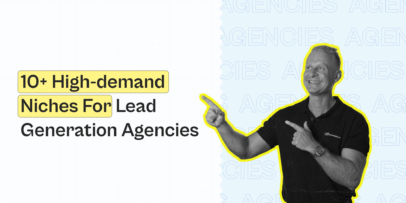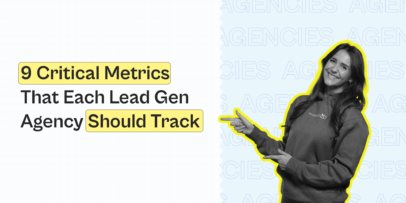How Much Does Lead Generation Cost? [In-Depth Analysis Of 100+ Lead Generation Agencies]
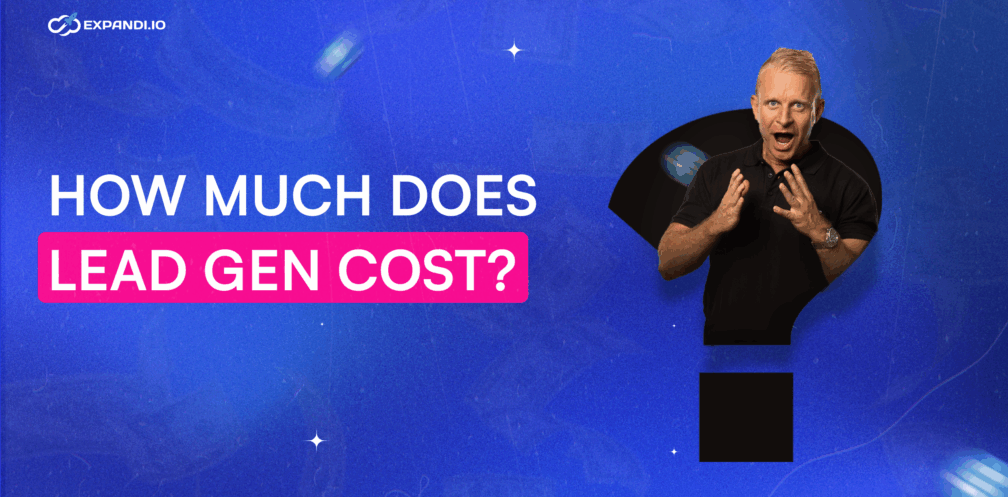
How much does lead generation cost?
If you ask five different agencies, you’ll get five different answers.
Some will quote you the price per lead, some do it on a commission basis, while others charge upwards of $10,000+/mo. All while most agency pricing pages are vague or intentionally hidden behind a demo call.
This is because pricing can be a huge competitive advantage for many lead generation agencies. And very few of them want to expose their margins, methods, or exact pricing models…
Fortunately, we did a deep dive into the topic and analyzed 100+ lead generation agencies, interviewed experts, obtained quotes, and compared them against industry-wide benchmarks.
So, if you’re curious exactly how much lead generation costs nowadays, here’s what you need to know.
TL;DR
- Most lead generation agencies use four pricing models:
- Cost per lead (CPL), cost per appointment (CPA), bulk data/list sales, and monthly retainers.
- Typical monthly retainers when hiring a lead gen agency include:
- Low-end: $500-$1,000/mo for light, productized LinkedIn or email outreach.
- Mid-tier: $1,500-$5,000/mo for more serious, outbound programs or mixed-channel lead generation services costs.
- High-end: $10,000+/mo for full outsourced SDR teams and enterprise, multi-region campaigns.
- B2B lead generation cost per lead (according to 2025 benchmarks from Sopro + First Page Sage):
- Around $50-$100 for lower-ticket, volume-driven industries (e.g., eCommerce, education, non-profit).
- Around $100-$250 in mid-range industries (e.g, SaaS, agencies).
- $400-$650+ in highly regulated, competitive verticals like legal or financial services. This is where the average cost per lead by industry spikes.
- Channel choice changes your lead generation cost per lead.
- SEO, email, and content sit on the lower end.
- While trade shows, events, and cold calling are at the very top of the cost spectrum.
- There is no single universal answer to what is a good cost per lead. It depends on your LTV/ACV, close rates, and sales cycle length.
- If you’re wondering how to optimize the cost of lead generation, most companies look at:
- Starting off with one or two proven channels (E.g., LinkedIn + email).
- Defining ICP + lead qualification rules before signing a contract.
- Comparing agencies on ROI and pipeline, not just headline pricing.
- Finally, if LinkedIn and email are part of your mix (for B2B, usually are), tools like Expandi let you run scalable, compliant outreach campaigns without jumping into costly retainers.
- For just $99/mo, you can test messaging, audience, and run multi-channel campaigns and start seeing results within 24h. Then, you can see whether scaling with an agency makes sense or not. Try Expandi with a 7-day free trial.
Our methodology
To prepare for this article, we analyzed the pricing strategies of over 100 lead generation agencies. That analysis included:
- Speaking to employees, CFOs, and CEOs to define what are lead generation costs.
- Obtaining real pricing quotes (lead generation cost per lead, what is a good cost per lead, etc.)
- Reviewing publicly available pricing sheets and case studies
- Calculating overhead, margins, and operational costs behind different pricing models
- Reviewing over 20,000+ words of lead generation content and 5+ hours of interviews/podcasts with agency operators.
Now, don’t worry — we don’t intend to bore you with every single one of our findings.
Instead, this article summarizes the most insightful findings to help you understand how much lead generation costs, how pricing models work, and how to optimize the cost of lead generation.
We do have more insights to share, however, so we recommend that you read these three articles as well:
- How To Start a Lead Generation Business? [Takeaways From Lead Gen. Agencies Doing Over $200m in Revenue Combined]
- Lead Generation Website — How To Capture as Many Leads on Your Website as Possible
- Lead Generation Processes, SOPs, and Frameworks From The World’s Best Companies
4 Most Common Lead Generation Pricing Models
Most lead generation companies use the same 3-4 pricing models. Mainly because:
- Clients know exactly what to expect (and transparency matters when they’re asking how much does lead generation cost)
- You don’t have to waste time explaining your pricing model in-depth
- It’s easier for agency owners to compare their margins to other agencies
- It’s easier for your management and finance teams
From our research, we discovered that the majority of lead generation agencies use one of these four pricing models:
1. Cost per lead (CPL)
The cost per lead pricing model is simple and highly attractive for clients to understand, especially when they’re comparing lead generation cost per lead across agencies or trying to benchmark what is a good cost per lead for their industry.
Here’s how it works:
- The agency calculates its internal cost to generate one lead.
- They add a margin and a fixed CPL price.
- You pay only for leads delivered.
Typical pricing here is $30-$400 per lead (highly depends on niche, LTV, intent, and qualification).
To maximize ROI, many agencies now implement multi‑stepped forms that pre‑qualify leads and increase conversion quality.
2. Cost per appointment
This pricing model only applies to agencies that help clients schedule demos or sales appointments for their leads — though many of these agencies offer cost-per-lead services as well.
Here’s how it works:
- The agency calculates their costs and expenses to generate one qualified appointment.
- Then they add their margin and set a flat per-appointment fee.
- You pay only for scheduled meetings, regardless of the outcome.
Because an appointment is further down the marketing funnel, the price is typically higher than CPL. This aligns with how buyers evaluate how much does lead generation cost, since appointment setting is usually the premier tier of lead generation services cost.
This model also helps clients compare whether paying per meeting offers a better ROI than the traditional lead-generation-cost-per-lead structure.
3. Bulk data purchasing
This pricing model is for agencies that offer clients leads from a pre-existing database. Usually, this is the simplest model, but also the lower quality option, mainly because it doesn’t generate leads, it only provides contact lists.
Here’s how it works:
- The agency collects large volumes of contact data (emails, phones, job titles, etc.) through certain AI sales tools.
- They calculate the total acquisition cost.
- They divide that cost across all buyers.
- You receive a flat-fee list of contacts.
These contacts typically have no intent, no qualification, and often poor accuracy. For this reason, bulk data is often the cheapest and least effective option.
Buyers often compare this option when trying to understand B2B lead generation cost tiers from cheapest to premium.
That said, the pricing will depend on where you’re buying your lead lists from. Typically, bulk data purchasing pricing ranges from:
- Fiverr lead lists: $5-$50 (typically risky and low quality).
- Credit-based data providers: $500-$3,500 for datasets
- Agency-sold bulk lists: Often bundles, several thousand dollars per list.
4. Retainer
The retainer is by far the most widely used (and typically most expensive) pricing structure for lead generation agencies.
If you’ve ever wondered how much does lead generation cost, chances are, they charge you on a monthly retainer. Because it gives them a predictable revenue and gives you all-inclusive services.
Here’s how it works:
- Estimates the monthly cost of running your campaigns (SDRs, tools, data providers, operations, etc.).
- Adds its profit margins.
- Charges you a fixed monthly fee for ongoing lead generation.
Contracts typically run for 3-12 months, though larger B2B programs may go up to 24 months. Each agency packages this differently, but typical retainer lead generation services include:
- Prospecting and list building.
- Multi-channel outreach (email, LinkedIn, calling).
- CRM integrations and reporting.
- Lead nurturing workflows.
- Copywriting and personalization.
- Tools and automation.
Across public pricing pages, agency proposals, and industry surveys, lead generation retainers generally cost anywhere from $1,500 to $20,000/month.
Depending on your industry competitiveness, lead volume, whether SDRs are included, if inbound + outbound are included, and so on.
What Is The Average Cost Per Lead and Cost Per Appointment? (Updated for 2025)
When companies search for how much does lead generation cost, the first benchmark they look for is the average cost per lead. But CPL varies widely depending on industry, channel, lifetime value, and buying intent.
That said, to give you the most accurate costs for 2025, we pulled data from:
- Sopro – B2B cost per lead benchmarks (2025)
- First Page Sage – Average cost per lead by industry (2025)
Here are the findings:
Average cost per lead by industry (2025)
| Industry | Average CPL |
| Legal services | ~$650 |
| Financial services | ~$461 |
| Cybersecurity | ~$448 |
| Real estate | ~$447 |
| Manufacturing | ~$188 |
| B2B SaaS | ~$188 |
| Marketing and agencies | ~$116 |
| eCommerce | ~$86 |
| Education | ~$85 |
| Non-profit | ~$43 |
Average lead cost varies from ~$100 for low-ticket industries to $400-$650+ for highly regulated sectors like finance or legal.
Average cost per lead by channel (2025)
| Channel | Average CPL |
| Trade shows and events | $800+ |
| Cold calling | ~$300 |
| SEM and Google Search | ~$110 |
| Display ads | ~$100 |
| Content marketing | ~$92 |
| Paid LinkedIn advertising | ~$75 |
| Webinars | ~$72 |
| Social media advertising | ~$65 |
| Email marketing | ~$53 |
| SEO | ~$31-$55 |
This strongly aligns with what buyers expect when evaluating how to optimize the cost of lead generation.
SEO, email, and webinars remain the most cost-effective channels, while trade shows and cold calling sit at the extreme high end.
What about cost per appointment?
Unlike CPL, cost per appointment (CPA) is harder to benchmark because most agencies don’t publicly disclose meeting-level economics.
The most credible publicly available data comes from Concept Ltd’s appointment-setting benchmarks, which reveal:
- Typical connect-to-meeting conversion rate: ~2-3%.
- Higher-intent industries can reach 5%+.
Using these metrics, we can estimate appointment costs roughly by multiplying CPL x leads per meeting.
For example:
- If your industry’s CPL is $180 and the meeting conversion rate is 3%:
- 33 leads needed for a meeting.
- 33 x $180 = ~$5,940 per booked meeting.
This is why actual cost per appointment varies drastically by industry.
That said, most publicly reported B2B benchmarks place common cost-per appointment ranges anywhere from $150 on the very low end all the way up to $900-$5,000+ in complex, enterprise environments.
But these figures should be treated as directional, not definitive.
What Are Lead Generation Costs? 7 Biggest Factors That Affect Pricing (2025)
If you’ve noticed a pattern in this article, it’s that the real answer to “how much does lead generation cost?” is always “it depends”.
That’s because CPL, CPA, and overall lead generation costs vary wildly based on a number of factors. These cost drivers typically are as follows.
1. Your industry and competitiveness
Industries with:
- Stricter regulations.
- Higher client lifetime value.
- Or heavy competition…
Tend to naturally have higher CPLs. For example, legal, cybersecurity, and financial services consistently sit at the higher end. While education and non-profit sit at the lower end.
This is the main reason why you always see B2B lead generation costs ranging from $50 all the way up to $600+.
2. Lead intent (cold, warm, inbound)
Higher-intent leads cost more because they convert more.
Cold outbound is typically the cheapest (and hardest) channel, while inbound or intent-based leads are the most expensive. This is also why benchmarks for what is a good cost per lead differ so much across industries.
3. The channel you use
Some channels are naturally more expensive than others because demand is higher and targeting is more refined.
For example:
- SEO + email = lower cost.
- Paid LinkedIn + SEM = mid-tier.
- Cold calling + trade shows = highest tier.
Your channel mix has a direct impact on your lead generation cost per lead.
4. Data quality and accuracy
Cheap lists = cheaper results.
High-quality datasets with verified emails, qualified profiles, or intent signals cost more upfront but dramatically reduce your actual CPL because:
- Fewer emails bounce.
- Outreach converts at a higher rate.
- More prospects fit your ICP.
- Sales reps waste less time on bad contacts.
Bad data is one of the biggest hidden drains on lead generation budgets.
5. Your ICP complexity
Geography is another important top cost driver.
Trying to target:
- CTOs.
- CISOs.
- Niche technical buyers.
- Enterprise buyers…
Will always increase your lead generation costs because these prospects are harder to reach, require tailored messages, and have stricter filters.
Leads in the U.S. and Western Europe also cost significantly more than in LATAM, Eastern Europe, or APAC. Because of higher ad auction prices, higher SDR wages, and more competition.
6. Service scope
Lead generation agency pricing changes dramatically if they include:
- Copywriting.
- Multi-channel outreach.
- SDRs.
- CRM setup.
- Lead nurturing.
- Reporting.
- And so on.
The broader the scope, the higher the lead generation cost.
7. Your internal sales processes
Even the best leads cost more if your sales processes are slow or inconsistent.
Slow response times and poor nurturing hurt your conversion rate. Meaning, a higher effective cost per appointment.
To keep your B2B lead generation costs under control:
- Consider starting with one primary channel (usually LinkedIn + email for outbound).
- Define clear ICP + qualification rules before signing any contract.
- Ask agencies for benchmarks by your industry, not generic averages.
- Measure cost per opportunity, not just lead generation cost per lead.
7 Examples of Lead Generation Pricing From Leading Companies or Agencies
To prepare for this article, we looked at pricing information for over 100 lead generation agencies.
If we went through them one by one, this article would be a pretty monotonous read.
So instead, we’re going to focus on five agencies that we believe represent the rest fairly well.
Without further ado…
#1. ServiceDirect

ServiceDirect has over 2000 clients. The agency has generated over $520 million in revenue and delivered over 2 million leads.
ServiceDirect has a fairly limited scope and focuses on clients in the home improvement, legal services, medical services, insurance, and automotive industries. They also work with small businesses offering:
- Computer repairs
- Printing
- Flight booking
- Flowers
- Internet and cable
- Hotel accommodation
ServiceDirect uses per-lead pricing. The agency has a set range for each industry — highly qualified leads cost more.
Here are some of the price ranges in the home improvement niche:
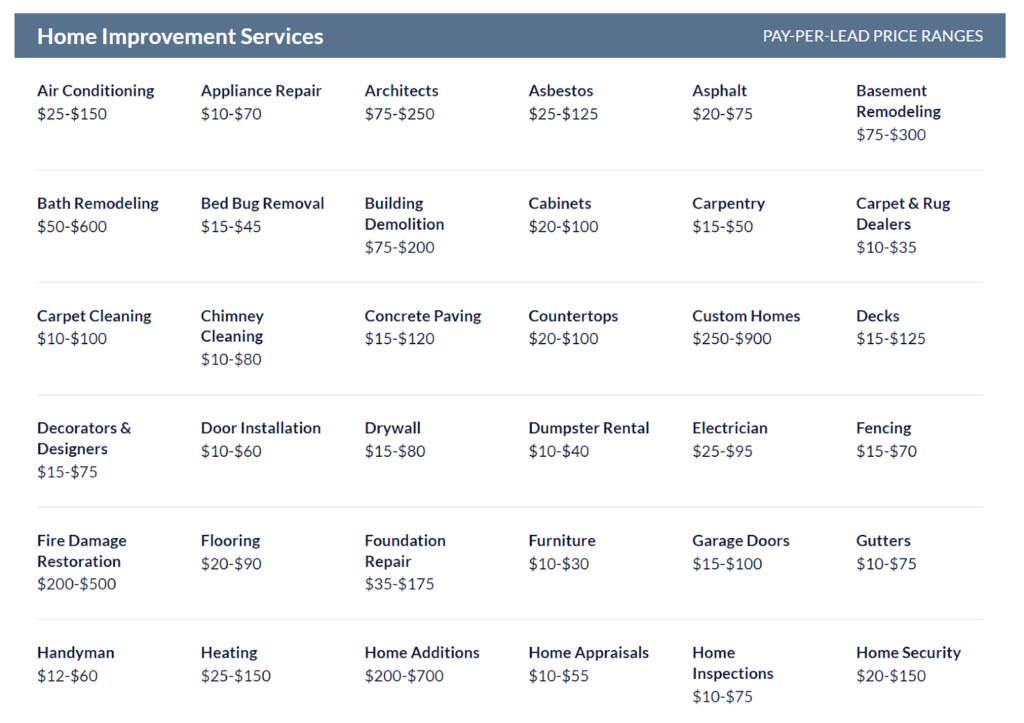
Here are the price ranges in the legal services niche:

Here are the price ranges in the medical services niche:

And here are the price ranges in the insurance, automotive, and small business niches:
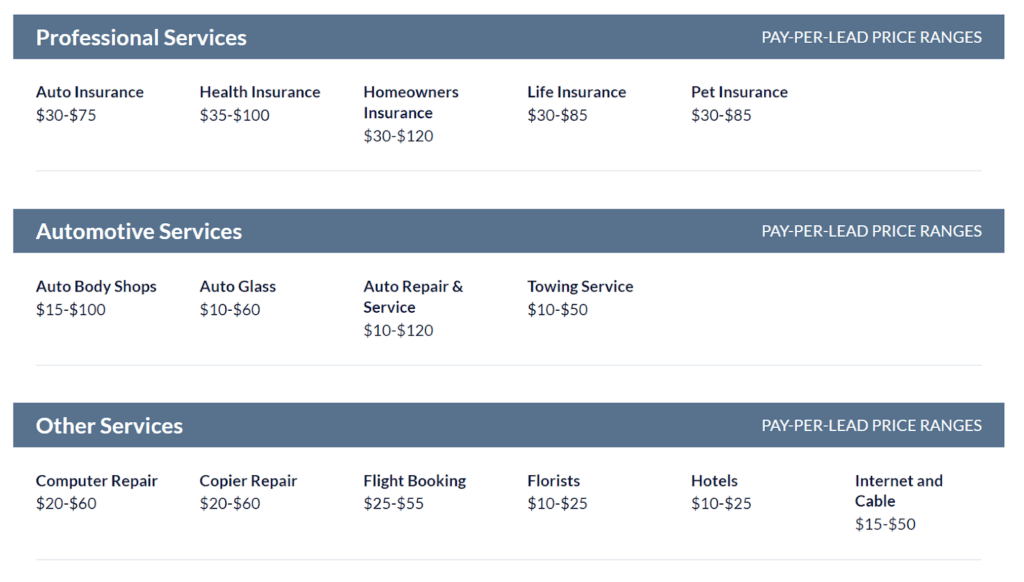
#2. The Martal Group

The Martal Group has a database of over 100 million contacts that was built over the twelve years the agency has been in business.
The Martal Group uses a flat fee per month price. The final price is determined by the client’s industry and the service tier they choose.
The Martal Group offers three service tiers:
- Tier one — Lead generation
- Tier two — Lead generation and customer onboarding
- Tier three — Lead generation, customer onboarding, and account management
Tier three is obviously the most expensive (and also the most effective).
The Martal Group’s new clients sign up for a three-month pilot campaign. If things go well, they transition into a monthly subscription.
The Martal Group uses a range of strategies, including email outreach, LinkedIn outreach, and cold calling. They also offer sales reps who can nurture leads for clients.
On average, the agency targets 3000 to 5000 leads per month for each client and flips five to 15 of them.
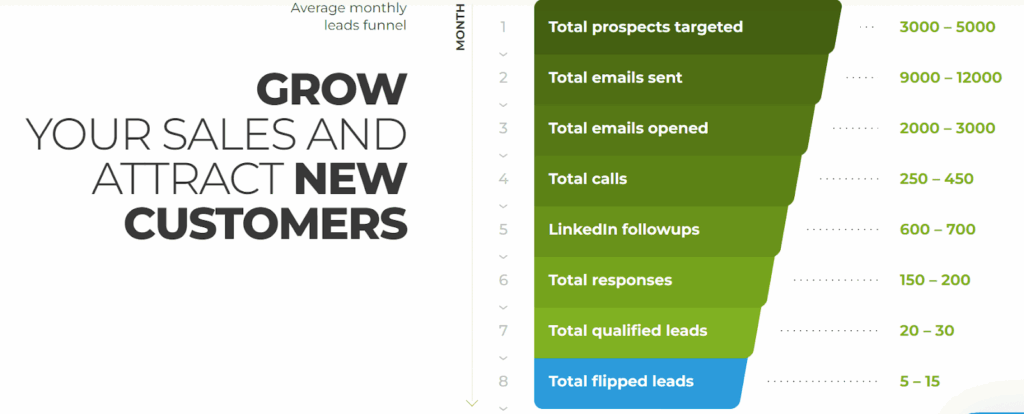
Securing appointments for clients is a major component of The Martal Group’s offering — so the agency charges clients more than many other competing agencies.
Our research indicates this price ranges from $2000 to $40,000 a month.
#3. Belkins

Belkins works with clients in Europe, Australia, North America, and South America. It’s a fairly new agency (founded in 2017). Belkins has scheduled 28,000+ appointments for clients, has 790+ clients, and offers a Return On Investment (ROI) of 10:1.
Belkins offers three “types” of services: appointment setting, inbound appointment setting (i.e., inbound lead generation), and LinkedIn influencer marketing.
Clients can choose to commit to a six-month-long or one-year-long contract.
For appointment setting, Belkins offers these plans:
- Startup — Netting customers 72+ appointments a year or 36+ appointments in six months
- Growth — Netting customers 120+ appointments a year or 60+ appointments in six months
- Growth Plus — Netting customers 360+ appointments a year or 180+ appointments in six months

For inbound appointment setting, Belkins offers these plans:
- Inbound Appointment Setting
- Inbound Appointment Setting + Post-Sales Enablement
- Post-Sales Enablement

For LinkedIn influencer marketing, Belkins offers these plans:
- LinkedIn Outreach
- LinkedIn Influencer + Outreach
- LinkedIn Influencer
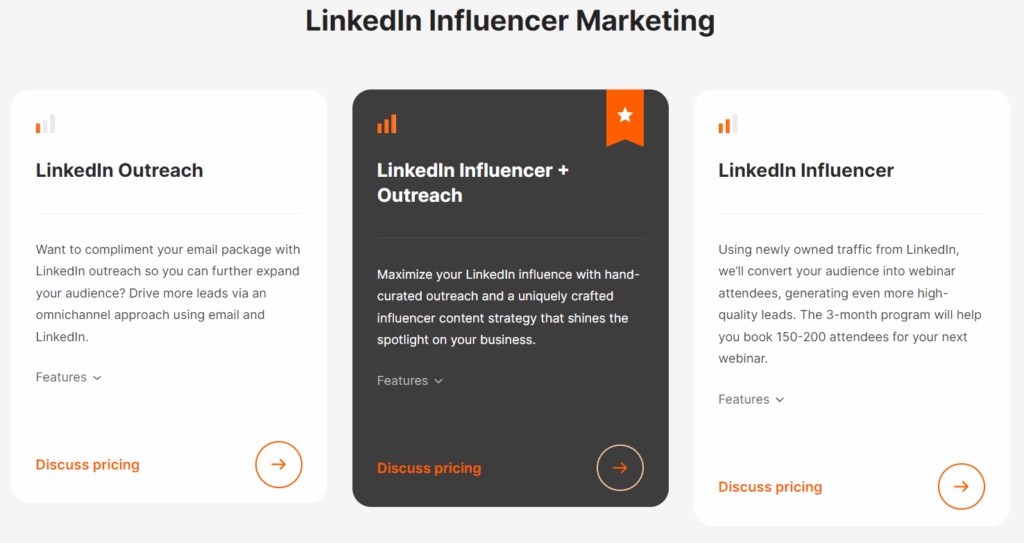
Belkins customizes prices based on clients’ goals, target audience, and industry. Our research indicates this price likely ranges from $3,000 to $70,000 (though the lowest appointment-setting plans likely start at around $13,000 for six months).
#4. Cience
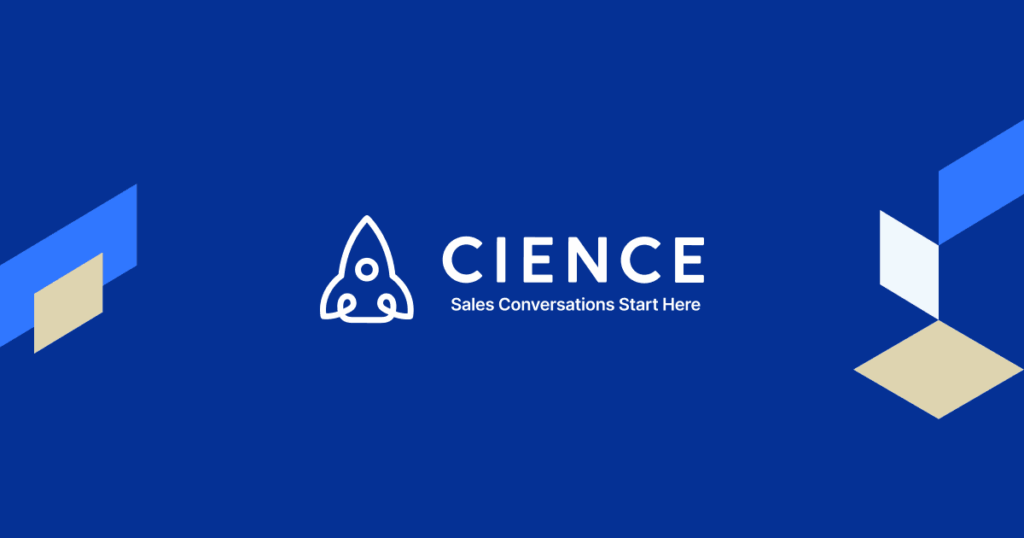
Cience has worked with over 2500 organizations in the software development, IT, finance, marketing, biotechnology, and education niches.
Cience offers six plans designed for organizations requiring different marketing services (from Ideal Customer Profile (ICP) building to generating leads). Several plans include full-time experts in marketing and content creation. Cience also offers Sales Development Representatives (SDRs).
Cience customizes the pricing of each plan depending on the client’s needs.
But they do offer an ROI calculator. This calculator shows that the cost for a single Cience SDR team is $64,800 for twelve months and $10,800 for one month.

Cience compares this cost to the cost of hiring your own SDR team. When accounting for hiring, training, overhead, salary, and management costs, Cience estimates that the team costs $131,159 annually or $10,930 monthly.

#5. BlueZebra Appointment Setting

BlueZebra has been in the market since 1999 and has worked with over 3000 companies. BlueZebra’s focus is solely virtual sales appointments and lead generation — the agency doesn’t offer any other services.
BlueZebra charges new clients an initial investment fee of $2,500. These funds will go towards developing a market-focused strategy suitable for the client’s specific ICP.
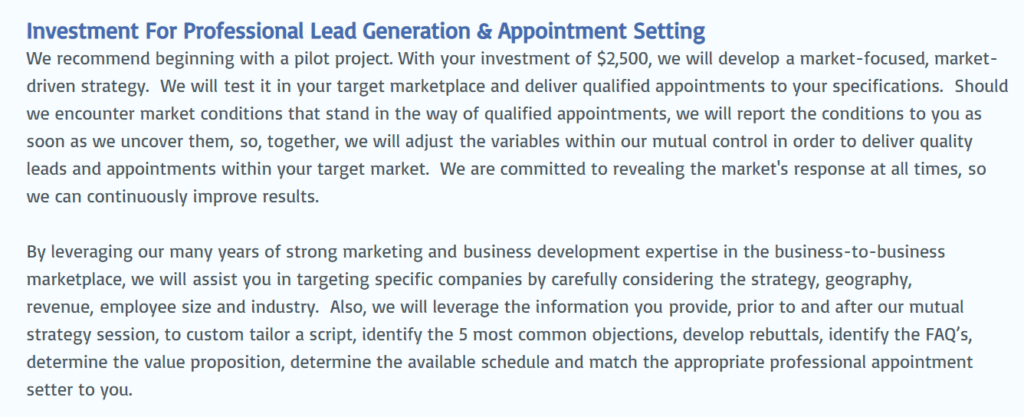
BlueZebra then charges a per-appointment fee for each lead they secure. The exact price for each lead depends on the client’s industry and goals.
Clients can exit their contracts by paying a $1,250 one-time fee.
BlueZebra’s customer service and reporting services are accounted for in the per-appointment fee.
#6. Cleverly
Cleverly is a LinkedIn-focused lead generation agency for B2B companies.
They’ve won clients for over 10,000+ clients across SaaS, consulting, marketing, finance, and more.
Cleverly operates on a monthly retainer model, rather than cost-per-lead or cost-per-appointment. Their pricing is completely transparent and based on productized plans:
- Silver – $397/mo. Includes LinkedIn outreach, personalized messaging, prospect list building, follow-up sequences, InMails, and ongoing optimization.
- Gold – Everything in silver, plus email outreach, multiple simultaneous campaigns, and advanced LinkedIn training.
- Platinum – Includes a dedicated appointment setter, inbox management, DFY meeting booking, and multi-channel outreach.

Cleverly also sells LinkedIn content/ghostwriting, and profile optimization services. Which complement their outbound campaigns but still fall under a retainer model.
This is one of the clearest examples of low-ticket, productized LinkedIn outbound pricing. Helpful when comparing lead generation costs against more complex SDR or multi-channel agencies.
#7. Saleseroads
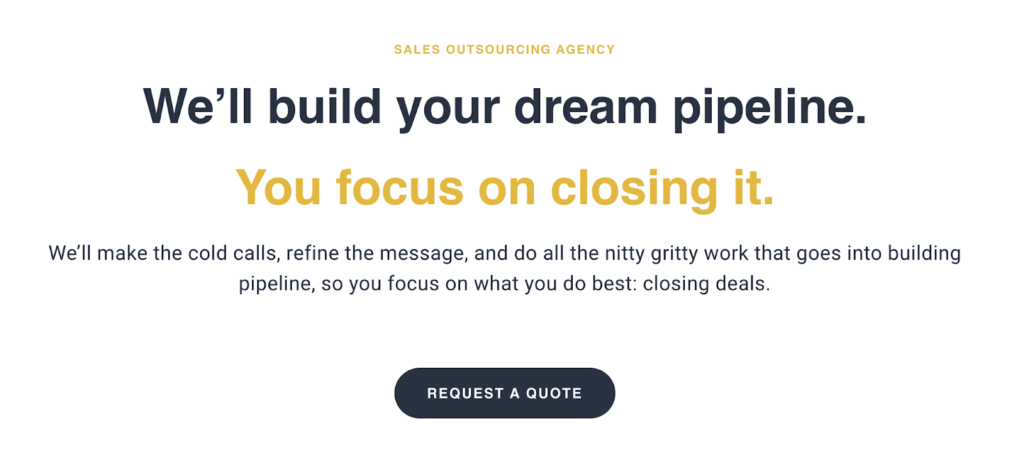
SalesRoads is a long-running outsourced SDR and appointment-setting agency, known for its high-volume calling programs, dedicated SDR teams, and enterprise-level sales outsourcing.
This lead generation agency uses a retainer-based pricing model, with a fully transparent 4-week cycle pricing. Starting at:
- $9,500/4 weeks – Full SDR appointment setting
- $9,500/4 weeks – Market research lead generation.

Both options come with a full SDR infrastructure rather than a single rep.
Because these programs included full-time SDRs, operations, QA, coaching, and data, SalesRoads sits in the premium retainer tier for B2B lead generation services.
#8. Callbox

Callbox is another B2B lead generation agency, with over 20+ years in operations, 15,000+ clients globally, and a hybrid human + AI service model.
Callbox focuses mainly on enterprise-level outbound and sales development.
And they are widely used by companies in SaaS, cloud, cybersecurity, fintech, healthcare, and more.
Callbox operates on a retainer-based “campaign pod” pricing model. Where each Pod functions as a complete outsourced SDR engine.
The estimated pricing per month per pod is between $15,000-$30,000+.

For that price, you get a dedicated SDR, client success manager, production manager, data researcher, personalization specialists, digital marketers, and more.
All this to say, lead generation agency pricing is anything but standardized. It varies massively based on your industry, company size, and overall requirements. And whether you need a simple outbound program or a full outsourced SDR engine depends on your budget, size, and goals.
Things to Consider When Looking at Lead Generation Prices
Now that we’ve covered agency pricing models, benchmarks, and real examples, the last piece of the puzzle is understanding why lead generation costs what it costs.
Here are the biggest cost components that influence the final price you pay:
- Overhead – software costs, operations, compliance, hiring, etc. Agencies running fully in-house SDR teams usually have a much higher overhead than software-first or automated agencies.
- Staffing costs – SDR salaries, training, QA, coaching, operations, and so on. If an agency includes dedicated SDRs, expect higher retainers. Because humans are usually the biggest resource. Sometimes though, those SDRs are on a commission basis (and/or small base pay).
- Campaign execution costs – LinkedIn tools (like $99 per seat for Expandi), email warmup tools, reporting, CRMs, integrations, and so on. All of these SaaS tools have their own subscription costs. And the broader the outreach scope, the higher the operational cost.
- Client success + reporting – Weekly meetings, CRM syncing, analytics dashboards, reports, etc. Agencies that offer high-touch support will usually charge premium retainers.
All this to say, a simple LinkedIn outreach service might cost a few hundred dollars per month. But a fully staffed outsourced SDR department with omni-channel smart campaigns can easily cost anywhere from $2,000-$10,000+/mo.
According to EmailToolTester, email marketing is the most effective lead generation channel, with 48% of marketers saying it’s their top method. Followed by website landing pages (44%) and content marketing (43%).
Final Thoughts: How Much Does Lead Generation Cost, Really?
If you’ve read this far, you’ve probably realized there is no single, universal answer to what are lead generation costs.
That said, here’s what you can expect from lead generation agencies:
- Low end: $500-$1,000/mo. A few hundred dollars per month for light, productized LinkedIn outreach or basic tools.
- Mid-tier: $1,500-$5,000/mo. This is what most serious outbound lead generation agencies or mixed-channel lead generation services cost.
- High-end: $10,000+/mo for full outsourced SDR teams and enterprise, multi-region campaigns.
What’s “expensive” or “cheap” depends less on the price tag and more on:
- Your industry and average deal size.
- Channel mix (inbound vs outbound).
- The service scope (list only vs fully DFY funnel).
- How well you turn leads into pipeline and revenue.
- And your requirements (reports, high-touch, etc.).
If you’re evaluating how much does a lead generation agency cost and what is a good cost per lead, a practical way to look at it is:
- Start from a unit number (LTV, ACV, close rates).
- Work backwards into a target CPL/CPA that still leaves healthy margins.
- Compare agencies not just on lead generation cost per lead, but on cost per opportunity, cost per closed-won deal, and overall ROI.
And finally, if LinkedIn is part of your mix (which it should be, given how strong it is for B2B), tools like Expandi can help you run scalable, compliant outreach without immediately jumping into costly retainers.
For $99/mo, you can run your own LinkedIn and email outreach campaigns, nurture your prospects with personalized messages at scale, and gain instant campaign reports.
Curious if Expandi is right for you?
Claim your free, 7-day trial and learn from here!
FAQ: How much does lead generation cost?
Lead generation typically costs anywhere from $30-$400+ per lead, depending on your industry, target audience, and lead intent. Agency retainers usually range from $1,500/mo all the way up to $10,000+/mo. While appointment-setting programs can cost from $150-$900+ per meeting.
The average B2B cost per lead is ~$198. Industries like legal, financial services, and cybersecurity sit on the higher end ($400-$650+), while education, marketing, and non-profit tend to be lower ($40-$110).
A good CPL is one that still produces profitable customers. A good rule of thumb:
If your CPL is under 10-20% of your ACV (annual contract value), it’s usually considered healthy and sustainable.
You can lower your CPL by focusing on:
– Clear ICP targeting.
– High-quality data.
– Multi-channel outreach (email + LinkedIn).
– Personalization and segmentation.
– Using automation tools (like Expandi) to reduce SDR and labor costs.
You’ve made it all the way down here, take the final step

